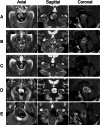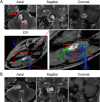Surgical timing and approach for brainstem cavernous malformation warranting thorough preoperative evaluation
- PMID: 40594083
- PMCID: PMC12216782
- DOI: 10.1038/s41598-025-03722-0
Surgical timing and approach for brainstem cavernous malformation warranting thorough preoperative evaluation
Abstract
Hemorrhage from brainstem cavernous malformations (BSCMs) can cause severe neurological dysfunction. While surgery is effective, the optimal timing remains unclear. This retrospective study aims to identify the best timing for surgery after hemorrhage in BSCM patients. Data from patients who underwent surgery between 2012 and 2022 were analyzed. Patients were divided into groups with favorable and unfavorable outcomes based on their best post-treatment modified Rankin Scale (mRS) scores. They were further categorized into four groups according to the timing of surgery after hemorrhage: hyperacute (≤ 7 days), acute (8-20 days), subacute (21-56 days), and chronic (> 56 days). Clinical characteristics, imaging findings, prognosis, and outcomes were compared between the groups. A total of 135 BSCM patients were included, with most lesions located in the pons. Surgical timing distribution was as follows: hyperacute phase (12 cases), acute phase (42 cases), subacute phase (69 cases), and chronic phase (12 cases). Of these, 113 patients had favorable outcomes. Statistical analysis revealed a significant difference in mRS scores between the four groups, with the most pronounced differences observed between the acute/subacute phases and the hyperacute/chronic phases. In conclusion, performing surgery in the acute and subacute phases could improve neurological function in BSCM patients.
Keywords: Brainstem cavernous malformations; Outcome; Surgical resection; Surgical timing.
© 2025. The Author(s).
Conflict of interest statement
Declarations. Competing interests: The authors declare no competing interests.
Figures




Similar articles
-
A multiregional multimodal machine learning model for predicting outcome of surgery for symptomatic hemorrhagic brainstem cavernous malformations.Neurosurg Focus. 2025 Jul 1;59(1):E7. doi: 10.3171/2025.4.FOCUS24778. Neurosurg Focus. 2025. PMID: 40591971
-
The role of DTI in surgical management of brainstem cavernous malformations: A meta-analysis of 4159 cases.J Clin Neurosci. 2025 Jul;137:111344. doi: 10.1016/j.jocn.2025.111344. Epub 2025 Jun 4. J Clin Neurosci. 2025. PMID: 40472436 Review.
-
Development and Validation of a Supplementary Grading Scale for Outcomes of Brainstem Cavernous Malformations.Stroke. 2024 Aug;55(8):1991-2002. doi: 10.1161/STROKEAHA.123.045943. Epub 2024 Jun 17. Stroke. 2024. PMID: 38881452
-
Pediatric brainstem cavernous malformations: 2-center experience in 40 children.J Neurosurg Pediatr. 2022 Mar 18;29(6):612-623. doi: 10.3171/2022.1.PEDS21538. Print 2022 Jun 1. J Neurosurg Pediatr. 2022. PMID: 35303707
-
Surgical management of pontine brainstem cavernous malformations: A systematic review Emphasizing safe entry zones and clinical outcomes.J Clin Neurosci. 2025 Apr;134:111106. doi: 10.1016/j.jocn.2025.111106. Epub 2025 Feb 5. J Clin Neurosci. 2025. PMID: 39914184
References
-
- Abla, A. A. et al. Advances in the treatment and outcome of brainstem cavernous malformation surgery: A single-center case series of 300 surgically treated patients. Neurosurgery68, 403–414 (2011). - PubMed
-
- <ISSVA-Classification-2018.pdf>.
-
- Gross, B. A., Batjer, H. H., Awad, I. A. & Bendok, B. R. Brainstem cavernous malformations. Neurosurgery64, E805-818 (2009). - PubMed
-
- Januszewski, J., Albert, L., Black, K. & Dehdashti, A. R. The usefulness of diffusion tensor imaging and tractography in surgery of brainstem cavernous malformations. World Neurosurg.93, 377–388 (2016). - PubMed
-
- Li, D. et al. Natural history of brainstem cavernous malformations: Prospective hemorrhage rate and adverse factors in a consecutive prospective cohort. J. Neurosurg.134, 917–928 (2020). - PubMed
MeSH terms
LinkOut - more resources
Full Text Sources

